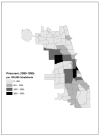Punishment's place: the local concentration of mass incarceration
- PMID: 21032947
- PMCID: PMC3043762
- DOI: 10.1162/daed_a_00020
Punishment's place: the local concentration of mass incarceration
Figures
References
-
- Blumstein Alfred, Cohen Jacqueline. Theory of the Stability of Punishment. Journal of Criminal Law and Criminology. 1973;64:198–207.
-
- Bureau of Justice Statistics. Prisoners in 2008. Washington, D.C: U.S. Department of Justice; 2009. http://bjs.ojp.usdoj.gov/content/glance/incrt.cfm.
-
- Pettit Becky, Western Bruce. Mass Imprisonment and the Life Course: Race and Class Inequality in U.S. Incarceration. American Sociological Review. 2004;69:151–169.
-
- Western Bruce. Punishment and Inequality in America. New York: Russell Sage Foundation; 2006.
-
- Clear Todd. Imprisoning Communities: How Mass Incarceration Makes Disadvantaged Neighborhoods Worse. New York: Oxford University Press; 2007.
Publication types
MeSH terms
Grants and funding
LinkOut - more resources
Full Text Sources




